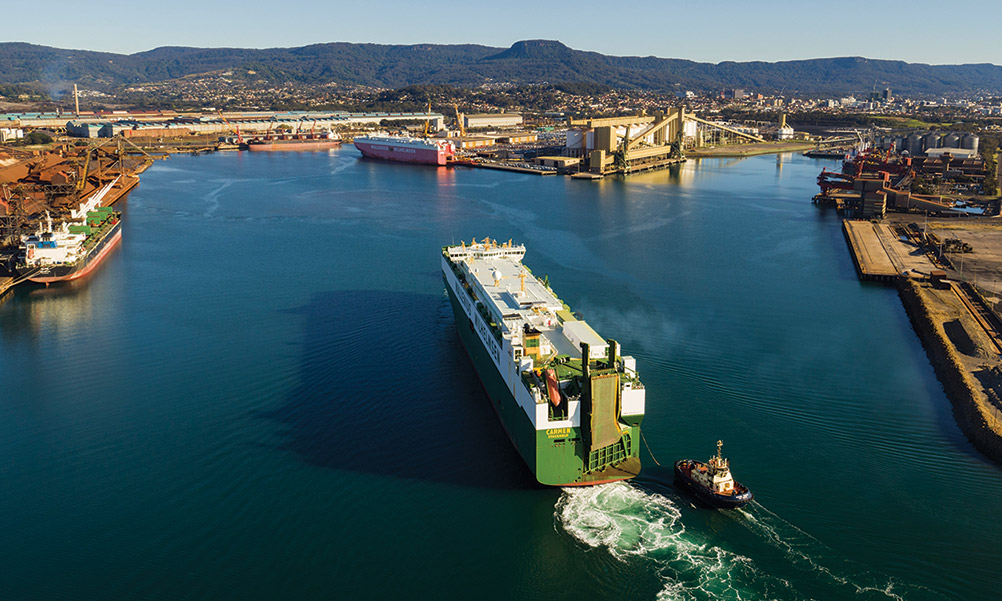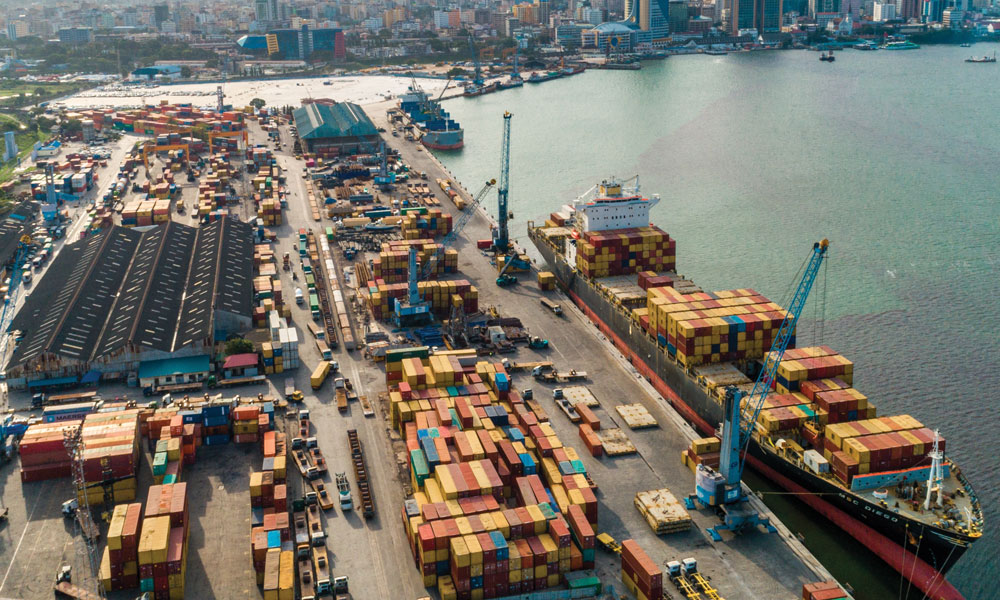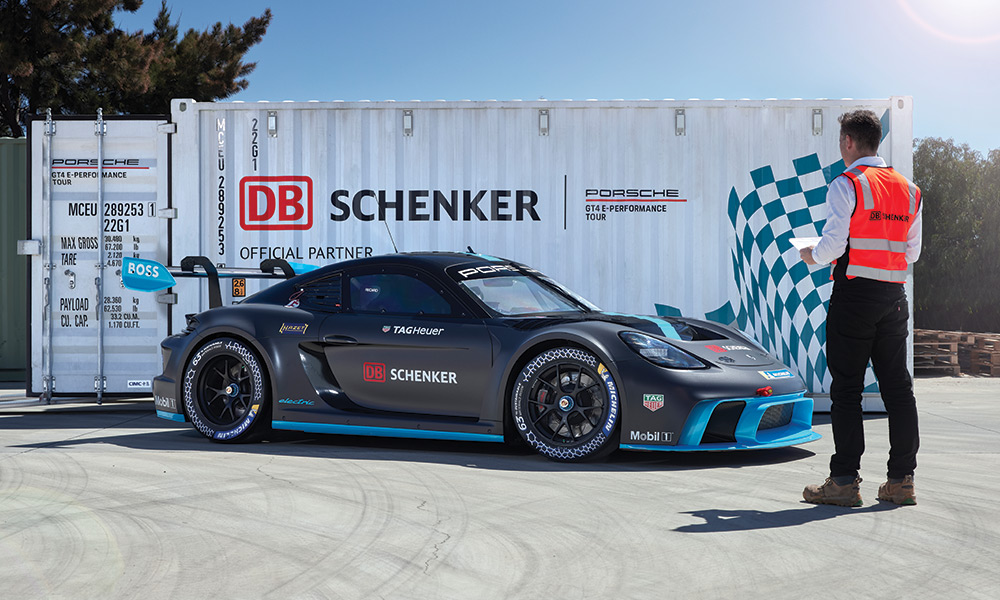THE ports of New South Wales handle more than imports and exports. They handle the pressures of the modern supply chain and the weight of economic responsibility. They are driving a shift to sustainability and renewable energy sources, for the maritime industry and the state itself.
New South Wales welcomed 5447 visits from commercial vessels in the 2022-23 financial year, according to data from the Port Authority of NSW.
The port authority also carried out 10,366 marine pilotage movements in the last financial year and responded to 239 marine incidents. Port Authority of NSW CEO Philip Holliday said most of those incidents were “relatively minor” mishaps in Sydney Harbour, but they all take resources and effort.
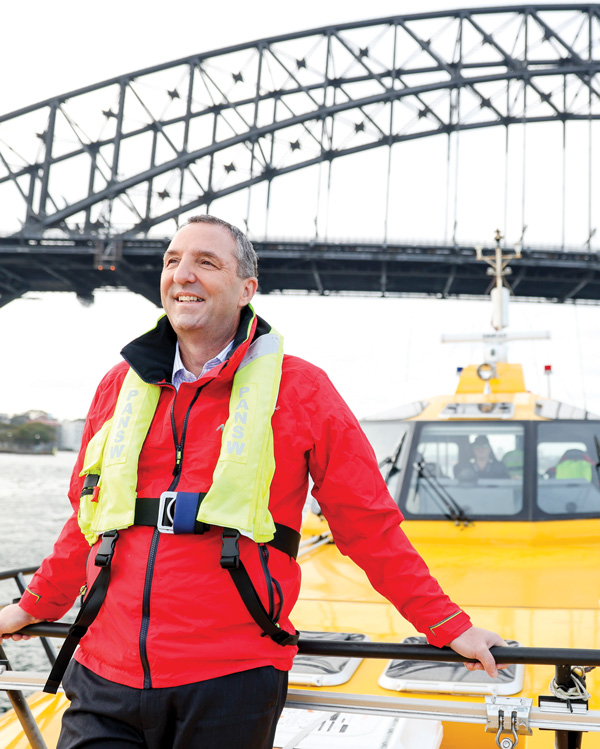
Port Authority of NSW CEO, Port Authority of NSW. Image: Port Authority of NSW © Salty Dingo
“If we do nothing else other than business as usual, it’s a pretty busy place,” Mr Holliday said.
And when it’s not business as usual – Mr Holliday recalled the Portland Bay incident in 2022 – the response is resource-intensive (in that instance, outright heroic) and a reminder that the port authority is more than a regulator.
“We’re a service provider, and we’re a state-owned corporation that aims to make a commercial return,” Mr Holliday said.
“And we did so with an economic return of $51.7 million and a net profit after tax of $22.5 million that the Port Authority put into the state’s coffers.”
Trade at a glance
Port Botany saw a decline in container volumes in December 2023 compared with the same month in 2022, according to the latest available monthly data from operator NSW Ports. The container-trade gateway of New South Wales handled a total of 200,720 TEU in December last year, down 7.3% from the 216,558 TEU handled in December 2022.
NSW Ports also manages Port Kembla, which is the largest motor-vehicle import terminal in New South Wales. While Port Kembla saw a 30.2% decline in ro-ro units handled in December 2023 compared with December 2022, motor vehicle imports for the six months ended December 2023 increased 6.5% to 210,386 units.
NSW Ports CEO Marika Calfas said trade volumes at Port Botany and Port Kembla over the past year were reflective of economic conditions.
“We’re looking at flat, if not slight declines in those trades that are linked to broader consumers and consumer sentiment,” Ms Calfas said.
“One area where we’ve seen more strength than others is motor vehicles; they’re still going strong in terms of volumes of imports, and that is purely driven by demand as well as clearing backlogs that have occurred over the past years.
“And the other area that is still strong, but not as strong as prior periods, is grain. We’ve still got good bulk grain exports, as we have in the last couple of years with good harvests.”
And the Port of Newcastle handled a throughput of 15.3 million tonnes in December 2023, which was a 10.2% increase from the 13.9 million tonnes in December 2022. Coal exports contributed 14.7 million tonnes to the December 2023 total.
“Our overall volumes have improved on 2022, largely with the shift in weather from La Niña and demand for coal, specifically China again exporting from Australia,” Port of Newcastle CEO Craig Carmody said.
“Our agricultural sector did not reach the same levels as 2021 and 2022, however that was expected with harvest volumes down due to drought impacting the New England and north-west of NSW.”
New arrivals
Ports along the state’s coast also welcomed kinds of vessels that were new or simply different. Mr Holliday noted the arrival of Shofu Maru into Newcastle last financial year. The bulk carrier was the first in the world to be equipped with a futuristic, Wind Challenger hard sail. The port authority also facilitated the arrival of the cruise ships Pacific Adventure and Disney Wonder, both of which needed modifications to fit under the Sydney Harbour Bridge.
“We talk to shipping companies all the time about what it is that they’re planning for the future,” Mr Holliday said.
“But typically, what we see is that we’re dealing with bigger vessels, different configurations of vessels and new cargoes.”
Mr Holliday used the example of LNG carriers coming to the Illawarra once the Port Kembla Energy Terminal is up and running. Squadron Energy is developing the terminal in Port Kembla’s Inner Harbour. Components of the project include a floating storage regasification unit (FSRU) and associated wharf and berth facilities. The project is slated for completion in 2025-26.
“That’s a new iteration of what we’re used to, and we don’t just accept these [vessels] when they come over the horizon; we do a lot of planning and preparation in advance for their arrival,” Mr Holliday said.
“We’ve worked really closely with the proponents for that – the design of the terminal and the way that it’s intended to operate – and we’re all aligned and comfortable with that. Work is progressing really well on the new location.”
Mr Holliday said the port authority will be ready for the FSRU and LNG carriers when they arrive in NSW.
“We’ve done lots of simulation work. The towage fleet in Port Kembla has been adjusted over the last couple of years, to make sure that we’ve got the right vessels. Svitzer is the provider of towage in Port Kembla, and we’ve been working very closely with them.
“The pilots have done that simulation training and are very comfortable with all that we’re working on. And you know, it will add further to the diversity of Port Kembla, which is a really good thing.”
There is a lot happening at the Port Authority of NSW, and Mr Holliday said there is a strong team working hard to keep everything moving.
“Just think of the value of all of the goods that have come in and out of New South Wales that, without the little old Port Authority, just wouldn’t happen.”
A vision for Newcastle
Last year Port of Newcastle launched its first regular container service. The service kicked off with the arrival of Neptune Pacific Direct Line container vessel Capitaine Dampier in September. Port of Newcastle said the service would see the port become a regular call for container vessels with import and export opportunities between Australia, New Zealand and the Pacific Islands.
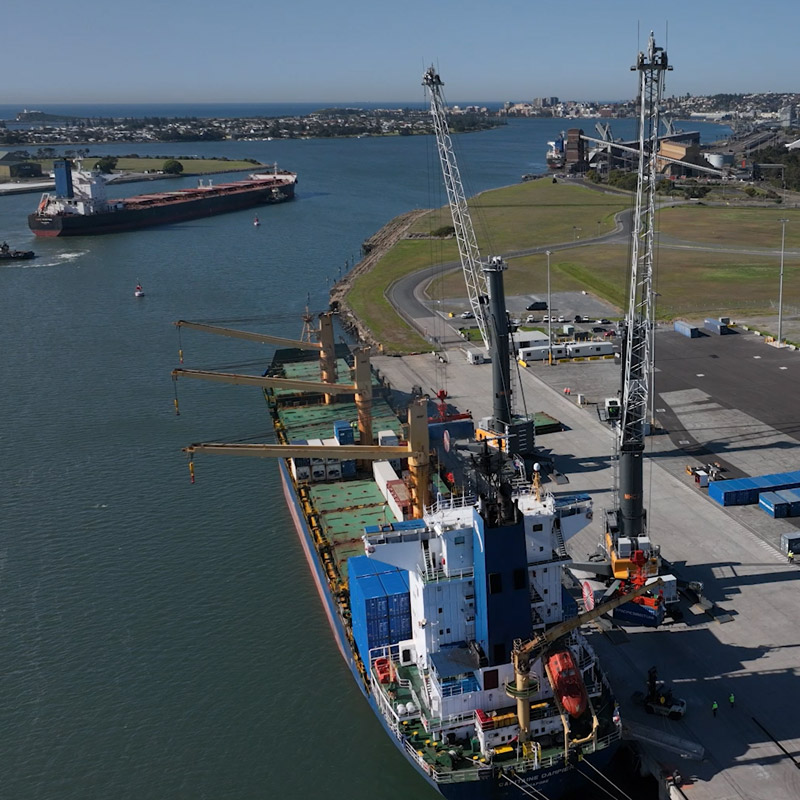
Capitaine Dampier at the Port of Newcastle. Image: Port of Newcastle
Another container shipping line is likely to begin calling Newcastle this year.
Mr Carmody said the port is still awaiting Independent Pricing and Regulatory Tribunal of NSW determination as the container trade gains momentum. In the meantime, the port’s immediate focus is on growing trade through the multipurpose terminal.
“The existing site can accommodate up to 150,000 TEU annually, with DA approval currently in place for up to 350,000 TEU each year. With this existing DA in place, an expanded hardstand and our mobile harbour cranes, our immediate attention will be growing these existing volumes,” Mr Carmody said.
“Our focus for 2024 will be on growing trade in the Australia Pacific region and improving our operations and efficiencies to accommodate new markets in 2025 and beyond.”
Port of Newcastle’s Clean Energy Precinct project is also powering along. The port released concept designs for stage one of the precinct in May last year, and in July the port clean-energy announced partnerships with 30 supportive organisations. Those partnerships were also expected to support the development of offshore wind projects as the government moved to declare an offshore wind zone for the Hunter coast.
The Clean Energy Precinct is moving to the second stage of planning and development.
“We recently hosted project partners Origin and KEPCO as they prepare for next phases of feasibility studies,” Mr Carmody said.
“The visit from KEPCO signifies the start of their feasibility study as a producer, which will aim to conclude in a development agreement with Port of Newcastle in the first half of 2024. As an organisation, our immediate focus for 2024 will be completing the deed of agreement for the $100 million in government funding, which will allow us to commence early infrastructure works.”
There are other developments on the horizon for Port of Newcastle, such as a ship unloader at the Walsh Point Bulk Precinct, due to come online in 2024.
“This will improve our environmental footprint and increase volume capabilities, improving discharge efficiencies and allowing for improved vessel turnaround times,” Mr Carmody said.
“Additionally, we are in the final stages of completing works that will see Port of Newcastle begin to accept passenger vehicles as a transit port initially. With biosecurity issues impacting ports around the country and delivery delays occurring, we see a market opportunity for Port of Newcastle to play a positive role in this space.”
Here’s the plan
And back at Port Botany and Port Kembla, NSW Ports has set in motion a plan targeting the growth of trade through the ports over the next 40 years.
NSW Ports launched its 2063 master plan last year. The plan forecasts container volumes increasing from 2.8 million TEU annually to more than 9 million TEU by 2063. It outlines the steps and investments that would need to happen to facilitate that growth.

NSW Ports CEO Marika Calfas. Image: NSW Ports
“We think those strategic plans are really important to give clarity as to the direction we’re headed as a business, but also as to what’s needed from others in the supply chain, including government in order to support the state’s trade needs, over the long period of time,” Ms Calfas said.
“The port itself can’t just cater for the trade needs of New South Wales if the policy, the regulatory, the infrastructure that is associated with the port, aren’t also accommodating that trade growth.”
Ms Calfas highlighted the expansion of container storage capacity at Port Botany last year with the construction of the Medlog empty container park. The site would be able to hold about 6000 TEU.
“It’s going to be a nice increase in empty container storage capacity at Port Botany to accommodate empty volume as we grow volumes to support the state.”
NSW Ports is also sharpening its focus on movement in landside logistics, and one of the main landside priorities right now is what Ms Calfas calls “the missing link” between the port and the state government’s Sydney Gateway interchange project.
“We need to connect that road to Port Botany so that we can have better flowing traffic and reduce some of the congestion that’s one of the core intersections there called General Holmes Drive,” she said,
“It’s particularly important because most of the traffic on Foreshore Road – which is the port’s main road – is more commuter traffic and traffic in surrounding suburbs that just doesn’t have other routes to be used. It’s important that that access to the port continues to be able to flow freely for the transport of goods.”
Winds of change
As Port Botany looks to increase container trade, Port Kembla is expected to become a critical part of the state’s green-energy future. The port is gearing up to facilitate more activity in offshore wind developments.
“Back in February, we released our artist’s impression of an offshore wind port facility down at the port to accommodate and support the development of offshore wind farms … in the Illawarra offshore wind zone,” Ms Calfas said.
The federal government in August 2023 opened consultation for a proposed offshore wind zone off the Illawarra coast. Ms Calfas said NSW Ports now has well-progressed designs for the facility, and the business is looking at how it would be built.
“The next step is that we’re waiting for the Illawarra offshore wind zone to be officially declared, and then we can have further engagement with potential users.”
But one of the immediate priorities for NSW Ports in Port Kembla is rail access.
NSW Ports has identified the proposed Maldon-Dombarton Line as one of several key rail infrastructure requirements for port rail growth and improving the state’s supply chains. According to the 2063 master plan, the rail link from Port Kembla to the Main South Line would reduce truck movements and improve network productivity. It would also connect “a future container terminal at Port Kembla” with the metropolitan intermodal network.
“The other driver for Maldon-Dombarton is the growth of construction products that we expect will be imported through Port Kembla,” Ms Calfas said.
“We expect that with the declining local sources of sand and aggregates, they’re going to become imports. Port Kembla makes sense [as] a port for them to be imported through. We already have cement being imported through Port Kembla, and some gypsum, and they can be distributed by rail, but they can’t if we don’t have that rail connection.”
Resilient ports
Ms Calfas said one of the more wholistic challenges for logistics in New South Wales is protection of industrial lands in Sydney.
“We need to preserve the remaining industrial lands,” she said.
“I think it’s gotten to the point where there is a recognition of this more broadly, not just in the industry, but with the government.
“However, I would we say we can’t ever rest on our laurels and think it’ll always be locked into everyone’s awareness. I think we have to keep communicating why industrial lands are important.”
Another ongoing issue for maritime logistics is disruption in its various forms.
“It’s the ones that are more protracted and ongoing that cause the biggest issue,” Ms Calfas said.
“That is where you end up with a whole lot of supply chain impacts that add to costs of goods, and adds to challenges around how the supply chain works.”
And Mr Holliday noted the disruptive impacts of extreme weather, geopolitical tensions and, in particular, the evolving threats to cybersecurity.
“Fortunately, it’s a very rare occurrence when something goes wrong. The consequences of it are significant, but the likelihood of it occurring is pretty rare. But you can’t really say that with cybersecurity threats; they’re only increasing and they’re getting more sophisticated.
“That’s a real focus of our attention – we’re investing a lot of time and effort into making sure that we’re as resilient as we can be.”
This feature article appeared in the February 2024 edition of the DCN Magazine.

